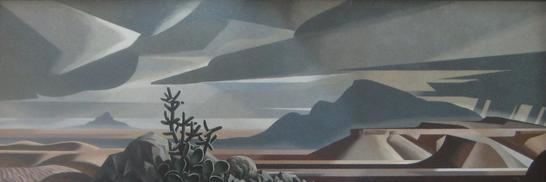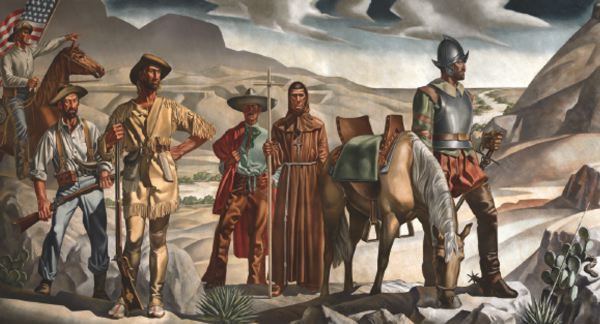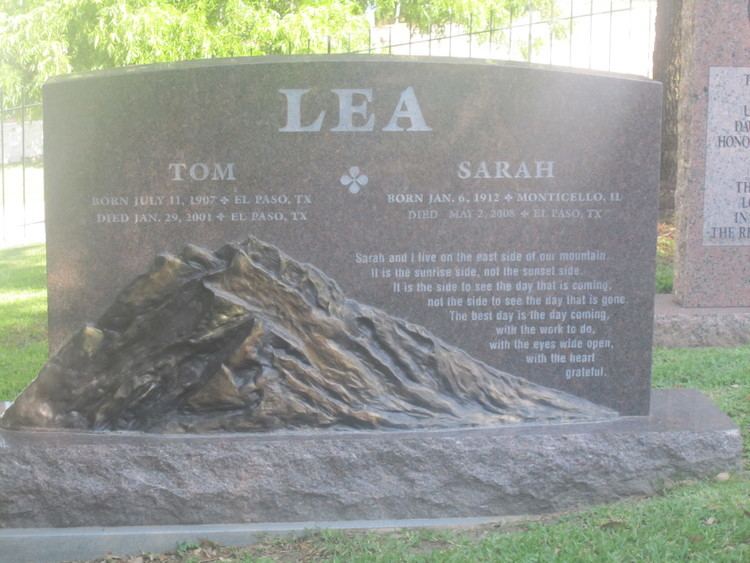Pen name Tom Lea Name Thomas Lea Role Artist | Nationality American Spouse Sarah Dighton (m. 1938) Children James Dighton Lea | |
 | ||
Books The Wonderful Country, The Brave Bulls, The two thousand yard stare, The Art of Tom Lea, Knight in the Sun: Harper B | ||
Thomas Calloway "Tom" Lea III (July 11, 1907 – January 29, 2001) was an American muralist, illustrator, artist, war correspondent, novelist, and historian.
Contents
- Biography
- Lifetime achievement
- Literature
- Public murals
- Paintings
- Major exhibitions
- Permanent collections
- References

The bulk of his art and literary works were about Texas, north-central Mexico, and his World War II experience in the South Pacific and Asia. Two of his most popular novels, The Brave Bulls and The Wonderful Country, are widely considered to be classics of southwestern American literature.
Biography

Lea was born in El Paso, Texas, to Thomas Calloway Lea Jr. (a prominent attorney), and the former Zola May Utt. From 1915 to 1917, his father was mayor of El Paso. As mayor, Tom Jr. made a public declaration that he would arrest Pancho Villa, after Villa raided Columbus, New Mexico, on March 9, 1916, if Villa dared enter El Paso. Villa then responded by offering a thousand pesos gold bounty on Lea. For six months Tom and his brother Joe had to have a police escort to and from school, and there was a 24-hour guard on the house.

He graduated from El Paso High School in 1924. From 1924 to 1926 he attended the Art Institute of Chicago and then apprenticed and assisted John W. Norton, a Chicago muralist, from 1927 to 1932.

In 1927, he wed Nancy June Taylor, a fellow art student. In 1930 Norton suggested that Tom take an art tour of Europe to study the masters. He and Nancy went to Paris and saw an exhibit of Eugène Delacroix at the Louvre, and Delacroix was his "favorite". Next they traveled to Florence, Orvieto, Rome, Capri. Then, after a four-month tour, it was back to Le Havre to catch the SS Ile de France.
After the tour of Italy they moved to Santa Fe to be with other artists and be in the Southwest. When Nancy became ill (a botched appendectomy) they moved to El Paso, and Lea found work from the Federal Art Project (FAP) for the Works Progress Administration (WPA), which during the Great Depression hired artists, and in Lea's case to paint murals in government buildings.
Lea also won the United States Department of the Treasury competition for a mural commission in the United State Post Office Department Building (now the William Jefferson Clinton Federal Building) in Washington, D.C., called The Nesters. His other murals included the post offices in Odessa, Texas (Stampede), Pleasant Hill, Missouri (Back Home, April 1865), and Seymour, Texas (Comanches). In 1936, his wife (in April), grandmother (in June), and his mother (in December), all died in that year.
In 1937 he started doing illustration work, and this led to a partnership with a friend of his father, author J. Frank Dobie. Dobie wrote about the rough life of settling the Texas frontier and Lea's illustrations are mostly of cowboys and the wild Texas landscapes. While painting a mural in El Paso Federal Courthouse (Pass of the North), he met and married his second wife, Sarah Catherine Beane (née Dighton), in July 1938. Sarah had come from Monticello, Illinois, to El Paso to visit friends. Sarah had a son, James (Jim), from a previous marriage whom Lea adopted. That same year his started his lifelong partnership with Carl Hertzog (Jean Carl Hertzog Sr.), an El Paso book designer and typographer. 1937–1938 would prove to be the antithesis of 1936, providing Lea with three lifelong partners and friends.
In 1940 he applied for and won Rosenwald Fellowship, but by the end of the summer of 1941, he got a telegram from LIFE asking him to go to sea with the United States Navy on a North Atlantic Patrol. In the fall of 1941, he decided to paint for LIFE as war artist and correspondent aboard a destroyer. He traveled all over the world with the United States military from 1941 to 1945. This included: China, Great Britain, Italy, India, North Africa, North Atlantic, the Middle East, and the Western Pacific. He went on deployment with the aircraft carrier USS Hornet in the Pacific Ocean in 1942, where he met the famous Army Air Corps pilot Jimmy Doolittle. Lea was on board the Hornet (September 15, 1942) when the USS Wasp was sunk by torpedoes from a Japanese submarine. He painted several pictures of the sinking of the Wasp. In 1943, during his visit to China, he met Theodore H. White, and he painted the portraits of Generalissimo Chiang Kai-shek and his wife, Soong Mei-ling; the head of the "Flying Tigers", and General Claire Lee Chennault.
But, it was his time in the western Pacific in 1944 as a combat correspondent with the United States 1st Marine Division during the invasion of the tiny island of Peleliu that he would really make a name for himself among the readers of LIFE. “My work there consisted of trying to keep from getting killed and trying to memorize what I saw and felt,” Lea says. His vivid, realistic, images of the beach landing, and Battle of Peleliu, would impact both readers and himself. The Price and That 2,000 Yard Stare would become among his most famous works. (1,794 Americans died in a two-month period it what many call the war's most controversial battle, due to its questionable strategic value and high death toll.)
In 1947 Lea finished a graphite sketch on kraft paper of his wife called Study for Sarah in the Summertime. He had started the sketch two years earlier, about six months after he got home from the war. The life size work (71" × 30¼") was based on a photograph, taken of Sarah in the backyard of their home at 1520 Raynolds Boulevard in El Paso, that he had carried in his wallet throughout the war. An oil painting, Sarah in the Summertime (67" × 32"), was then done from the sketch. He spent longer on this combined work than any other painting.
After finishing his last novel, The Hands of Cantu (an account of horse training in 16th-century Nueva Viscaya) in 1964, Lea traveled to Boston to meet with his publishers, Little, Brown and Company. He told them that he wasn't interested in another novel, so they suggested a book about his pictures. This 1968 work, A Picture Gallery, was his "autobiography", writing of why and when he did his paintings. Working on A Picture Gallery would lead him to once again focus on painting and turn away from working on literature. Right before finishing this work, Baylor University paid tribute to his writing by bestowing him, and his long-time friend Carl Hertzog, with an honorary doctorate's in literature.
Lifetime achievement
Literature
Public murals
State of Texas Centennial Commission, Federal Art Project (FAP) for the Works Progress Administration (WPA) and Public Works of Art Project for the United States Department of the Treasury.
